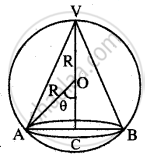Advertisements
Advertisements
प्रश्न
Prove that the volume of the largest cone that can be inscribed in a sphere of radius R is `8/27` of the volume of the sphere.
उत्तर
Let VAB be the volume of the largest cone contained in the sphere.
Obviously, for maximum volume, the axis of the cone should be along the height of the sphere.

Let, ∠AOC = θ
∴ AC, the radius of the base of the cone = R sin θ, where R
is the radius of the sphere.
Height of the cone VC = VO + OC = R + R cos θ
Volume of a cone; V = `1/3 pi (AC)^2 xx (VC)`
`=> V = 1/3 piR^2 sin^2 θ (R + R cos theta)`
`=> V = 1/3 piR^3 sin^2 theta (1 + cos theta)`
On differentiating
`therefore dV/(d theta) = 1/3 piR^3 [sin^2 theta (- sin theta) + (1 cos theta) * 2 sin theta cos theta]`
`= 1/3 piR^3 [- sin^3 theta + 2 sin theta cos theta + 2 sin theta (1 - sin^2 theta)]`
`= 1/3 piR^3 [- sin^3 theta + 2 sin theta cos theta + 2 sin theta - 2sin^2 theta]`
`= 1/3 pi R^3 [- 3 sin^3 theta + 2 sin theta + 2 sin theta cos theta]`
For minimum and maximum, `(dV)/(d theta) = 0`
`=> 1/3 pi"R"^3 (- 3 sin^3 theta + 2 sin cos theta + 2 sin theta)` = 0
= - 3 sin3 θ + 2 sin θ cos θ + 2 sin θ = 0
= sin θ (- 3 sin2 θ + 2 cos θ + 2) = 0
= - 3 sin2 θ + 2 cos θ +2 = 0 ...[∵ sin θ ≠ 0]
= -3 (1 - cos2 θ) + 2 cos θ + 2 = 0
= - 3 + cos2 θ + 2 cos θ + 2 = 0
⇒ 3 cos2 θ + 2 cos θ - 1 = 0
⇒ (3 cos θ - 1)(cos θ + 1) = 0
⇒ cos θ = `1/3` cos θ = - 1
But cos θ ≠ 1 because cos θ = - 1 ⇒ θ = π which is not possible.
`therefore cos theta = 1/3`
When `cos theta = 1/3`, then `sin theta = sqrt(1 - cos^2 theta) = sqrt(1 - 1/9)`
`= sqrt(8/9)`
`= (2 sqrt2)/3`
Now `(dV)/(d theta) = 1/3 piR^3 sin theta [- 3 sin^2 theta + 2 + 2 cos theta]`
`= 1/3 piR^3 sin theta (3 cos theta - 1)(cos theta + 1)`
The sign of `cos theta = 1/3, (dV)/(d theta)` changes from +ve to -ve.
∴ V is highest at `theta = cos^-1 (1/3)`.
On decreasing θ, cos θ increases.
Now cos θ = `1/3` then V is maximum.
The height of the cone for this value of cos θ is
VC = R + R cos θ
`= R + R xx 1/3 = (4R)/3`
Radius of cone = AC = R sin θ = `R * (2sqrt2)/3 = (2 sqrt2)/3 R`
∴ Maximum volume of the cone is V
`= 1/3 pi (AC)^2 (VC)`
`= 1/3 pi ((2 sqrt(2R))/3)^2 ((4R')/3)`
`= 1/3 pi xx 8/9 R^2 xx (4R)/3`
`= 8/27 (4/3 piR^3)`
`= 8/27 xx` Volume of sphere
APPEARS IN
संबंधित प्रश्न
Find the maximum and minimum value, if any, of the function given by f(x) = |x + 2| − 1.
Find the local maxima and local minima, if any, of the following function. Find also the local maximum and the local minimum values, as the case may be:
f(x) = x3 − 6x2 + 9x + 15
Prove that the following function do not have maxima or minima:
f(x) = ex
Find the maximum value of 2x3 − 24x + 107 in the interval [1, 3]. Find the maximum value of the same function in [−3, −1].
Find two positive numbers whose sum is 16 and the sum of whose cubes is minimum.
A rectangular sheet of tin 45 cm by 24 cm is to be made into a box without top, by cutting off square from each corner and folding up the flaps. What should be the side of the square to be cut off so that the volume of the box is the maximum possible?
A wire of length 28 m is to be cut into two pieces. One of the pieces is to be made into a square and the other into a circle. What should be the length of the two pieces so that the combined area of the square and the circle is minimum?
Find the maximum area of an isosceles triangle inscribed in the ellipse `x^2/ a^2 + y^2/b^2 = 1` with its vertex at one end of the major axis.
Find the points at which the function f given by f (x) = (x – 2)4 (x + 1)3 has
- local maxima
- local minima
- point of inflexion
Find the absolute maximum and minimum values of the function f given by f (x) = cos2 x + sin x, x ∈ [0, π].
A metal box with a square base and vertical sides is to contain 1024 cm3. The material for the top and bottom costs Rs 5 per cm2 and the material for the sides costs Rs 2.50 per cm2. Find the least cost of the box
Show that the height of a cylinder, which is open at the top, having a given surface area and greatest volume, is equal to the radius of its base.
Divide the number 20 into two parts such that sum of their squares is minimum.
Show that the height of a closed right circular cylinder of given volume and least surface area is equal to its diameter.
Solve the following : Show that of all rectangles inscribed in a given circle, the square has the maximum area.
Solve the following : Show that the height of a right circular cylinder of greatest volume that can be inscribed in a right circular cone is one-third of that of the cone.
Solve the following : Show that the height of the cylinder of maximum volume that can be inscribed in a sphere of radius R is `(2"R")/sqrt(3)`. Also, find the maximum volume.
Determine the maximum and minimum value of the following function.
f(x) = 2x3 – 21x2 + 36x – 20
Divide the number 20 into two parts such that their product is maximum
The minimum value of Z = 5x + 8y subject to x + y ≥ 5, 0 ≤ x ≤ 4, y ≥ 2, x ≥ 0, y ≥ 0 is ____________.
If f(x) = 3x3 - 9x2 - 27x + 15, then the maximum value of f(x) is _______.
If R is the circum radius of Δ ABC, then A(Δ ABC) = ______.
If f(x) = `x + 1/x, x ne 0`, then local maximum and x minimum values of function f are respectively.
Find all the points of local maxima and local minima of the function f(x) = `- 3/4 x^4 - 8x^3 - 45/2 x^2 + 105`
If the sum of the surface areas of cube and a sphere is constant, what is the ratio of an edge of the cube to the diameter of the sphere, when the sum of their volumes is minimum?
The sum of the surface areas of a rectangular parallelopiped with sides x, 2x and `x/3` and a sphere is given to be constant. Prove that the sum of their volumes is minimum, if x is equal to three times the radius of the sphere. Also find the minimum value of the sum of their volumes.
The function `"f"("x") = "x" + 4/"x"` has ____________.
Range of projectile will be maximum when angle of projectile is
The function `f(x) = x^3 - 6x^2 + 9x + 25` has
The maximum value of `[x(x - 1) + 1]^(2/3), 0 ≤ x ≤ 1` is
Read the following passage and answer the questions given below.
|
|
- Is the function differentiable in the interval (0, 12)? Justify your answer.
- If 6 is the critical point of the function, then find the value of the constant m.
- Find the intervals in which the function is strictly increasing/strictly decreasing.
OR
Find the points of local maximum/local minimum, if any, in the interval (0, 12) as well as the points of absolute maximum/absolute minimum in the interval [0, 12]. Also, find the corresponding local maximum/local minimum and the absolute ‘maximum/absolute minimum values of the function.
The range of a ∈ R for which the function f(x) = `(4a - 3)(x + log_e5) + 2(a - 7)cot(x/2)sin^2(x/2), x ≠ 2nπ, n∈N` has critical points, is ______.
If p(x) be a polynomial of degree three that has a local maximum value 8 at x = 1 and a local minimum value 4 at x = 2; then p(0) is equal to ______.
If S1 and S2 are respectively the sets of local minimum and local maximum points of the function. f(x) = 9x4 + 12x3 – 36x2 + 25, x ∈ R, then ______.
The sum of all the local minimum values of the twice differentiable function f : R `rightarrow` R defined by
f(x) = `x^3 - 3x^2 - (3f^('')(2))/2 x + f^('')(1)`
The minimum value of 2sinx + 2cosx is ______.
The maximum distance from origin of a point on the curve x = `a sin t - b sin((at)/b)`, y = `a cos t - b cos((at)/b)`, both a, b > 0 is ______.
Find the maximum profit that a company can make, if the profit function is given by P(x) = 72 + 42x – x2, where x is the number of units and P is the profit in rupees.
A metal wire of 36 cm long is bent to form a rectangle. Find its dimensions when its area is maximum.

